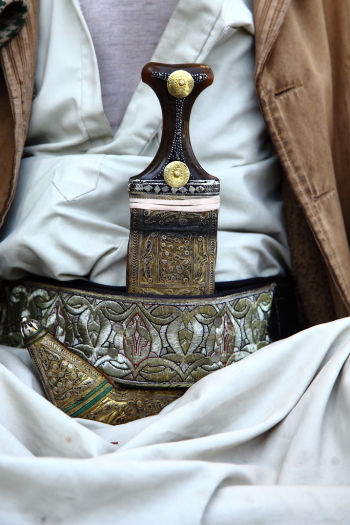
 |
Updated: 2023.07.11![]()
 |
The Roman (Latin) term sicarius (assassin) derives from sica (dagger), from which "sickle" derived.![]()
Even the derivation and meaning of the word "sicarii" is disputed based on geography (European versus Persian & Middle East) and religious agenda. with those foreign to the Middle East maintaining that the "Sicarii" knife derived from Roman Empire Europe, "possibly" from proto-Albanian, in turn "possibly" from Proto-Indo-European, "possibly" via Thracians, Dacians and Illyrian—all denying the reality of the Middle Eastern peoples who carried and used them.
Unlike the straight-bladed Roman pugio, the "sicarii" is widely recognized to have been a "curved dagger" from a Persian design adapted throughout the Middle East as carried by Middle Easter—not European Roman—Jews.
referring to the Hebrew/Aramaic ![]() "not much different in length from the Persian ἀκινάκης, but somewhat crooked, and like the Roman sicae, [or sickles,] as they were called" (Ant. 20.8, 10)
"SICARII... The name derived from the Latin word sicæ, "curved dagger"; in Roman usage, sicarii, i.e., those armed with such weapons, was a synonym for bandits. According to Josephus, the Jewish Sicarii used short daggers, μικρἁ Ξιφίδια (mikra ziphidia), concealed in their clothing, to murder their victims, usually at religious festivals (Wars, 2:254–5, 425; Ant., 20:186–7). The fact that Josephus employs the Latin sicarii, transliterated into Greek as σικαριοι (sikarioi) suggests that he adopted a term used by the Roman occupation forces; his own (Greek) word for "bandit," which he more generally uses to describe the Jewish resistance fighters, is λησταί (lestai)." https://www.jewishvirtuallibrary.org/sicarii
"not much different in length from the Persian ἀκινάκης, but somewhat crooked, and like the Roman sicae, [or sickles,] as they were called" (Ant. 20.8, 10)
"SICARII... The name derived from the Latin word sicæ, "curved dagger"; in Roman usage, sicarii, i.e., those armed with such weapons, was a synonym for bandits. According to Josephus, the Jewish Sicarii used short daggers, μικρἁ Ξιφίδια (mikra ziphidia), concealed in their clothing, to murder their victims, usually at religious festivals (Wars, 2:254–5, 425; Ant., 20:186–7). The fact that Josephus employs the Latin sicarii, transliterated into Greek as σικαριοι (sikarioi) suggests that he adopted a term used by the Roman occupation forces; his own (Greek) word for "bandit," which he more generally uses to describe the Jewish resistance fighters, is λησταί (lestai)." https://www.jewishvirtuallibrary.org/sicarii
 350x365.jpg) |
The JanᵊbiyꞋyâ is the curved dagger, worn for millennia throughout the ancient Middle East on the belt under one's cloak. While it's presence in the ancient Middle East is reportedly noted from c. BCE 4,000, it is first noted in the historical record as the dagger of the Qa•nâyꞋim. Today, only Arabs continue to wear the JanᵊbiyꞋyâ.
“Archaeological studies in the region have traced the Janbiya's origins as early as 6000 years back, where men of early civilizations that once dominated the region are shown with Janbiyas wrapped around their waists in ancient manuscripts & drawings, among which is the Kingdom of Sheba that was once ruled by the widely celebrated queen of Sheba (pronounced as the kingdom of “Sabaa” in Arabic) which modern evidence tends towards it's existence in Yemen in southern Arabia.
“Early Janbiya's hilts were made mainly out of a Rhino's horn & this tradition continued till today, where the most prestigious & high priced Janbiyas are made out of the same material.”
 |
“Evidence of the oldest janbiyas show they were worn in Sheban times, in the Himiarite kingdom; a statue of the Sheban king dating from 500 B.C. includes a janbiya … It is said that no man is complete without his janbiya. …
“The Jewish artisans of Yemen proved to be great geniuses in manufacturing the janbiya and it became their exclusive profession. Individuals and sometimes entire families gained celebrity for their fine workmanship of the janbiya. That tradition in Yemen largely ended when virtually all Jewish Yemenis migrated to Israel around 1949.”
In Yemen, the JanᵊbiyꞋyâ is worn by all Arab men, exclusively; the symbol of their manhood—but Arabs racistly prohibited any Yemenite Jew from wearing the JanᵊbiyꞋyâ Arab symbol of manhood.
“…the dagger also served, and still serves, as a status symbol with every male, from the humblest to the richest, wearing their jambiya as a sign of strength, manhood and self-sufficiency…
A prestigious type of jambiya… is worn … tucked to the side
of a man’s waist rather than in front of the stomach.”
The PBH![]() term for "dagger", פּוּגְיוֹן, derives from the Roman Latin: Pugio.
term for "dagger", פּוּגְיוֹן, derives from the Roman Latin: Pugio. ![]()
 |
| 1st Century CE Roman Pugio in sheath (photo romancoins.com |
 |
| 1st Century CE Roman Pugio beside sheath (photo romancoins.com |
Pay it forward! Quote & Cite:
| Ben-David, Yirmeyahu. Netzarim Jews World Headquarters, Ra'anana, Israel. www.netzarim.co.il. Title of this page. Copy & paste URL of this page. Today's date. |
 |
 |